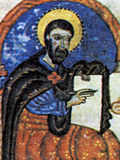Agathangelos

Agathangelos (in
The "standard" version of Agathangelos' history accepted in the Armenian tradition dates to the second half of the 5th century. This version was soon translated into Greek; on the basis of this Greek translation, a translation into Arabic was made, as well as many secondary Greek, Latin and Ethiopic versions. Another, earlier Armenian version of the history, now lost, was the basis for two Greek, two Arabic, and a Karshuni translation.[3]
He claims to be a secretary of
According to Agathangelos, he was tasked by Tiridates III to write about his father Khosrov II of Armenia and his reign period. Until the 19th century, based on this fact, scholars believe that Agathangelos lived in the 4th century. Later there attempts were made by researchers to demonstrate that Agathangelos lived and worked in the 5th century and was not able to be Tiridates III's secretary.[citation needed]. The opinion among many scholars however prevails that the systemic approach of the Armenian historiography allows calculating the approximate dates of the most authors. For instance, Ghazar Parpetsi, whose biographical data are known (second half of Vth century – beginning of VIth) century calls him the author of the “Third Book”. He calls P'awstos Buzand born before him the author of the “Second Book” and Agathangelos, the author of the “First Book”. Buzand has the same approach. Also, in his book each author focuses in greater details on the events happening during or close to his own live: Parpetsi's focus was the liberation wars led by Mamikonyans (450 - 484), Buzand describes in more details events of the second half of the IV century, and Agathangelos provides details of the adoption of Christianity and events in the first half of the IV century.[7]
Notes
- ^ Redgate 2000, p. 122.
- ^ a b Thomson 1991.
- ^ Thomson 1984.
- ^ Cross & Livingstone 2005.
- ^ a b One or more of the preceding sentences incorporates text from a publication now in the public domain: Chisholm, Hugh, ed. (1911). "Agathangelus". Encyclopædia Britannica. Vol. 1 (11th ed.). Cambridge University Press. p. 370.
- ^
 One or more of the preceding sentences incorporates text from a publication now in the public domain: Herbermann, Charles, ed. (1913). "Agathangelus". Catholic Encyclopedia. New York: Robert Appleton Company.
One or more of the preceding sentences incorporates text from a publication now in the public domain: Herbermann, Charles, ed. (1913). "Agathangelus". Catholic Encyclopedia. New York: Robert Appleton Company.
- ^ Ghazar Parpetsi, History of Armenians, p. 1.
Sources
- Agatʻangeghos (1983). Ter-Mkrtchian, G.; Kanayants, S. (eds.). Hayotsʻ patmutʻyun Հայոց Պատմություն [History of Armenia]. Translation into modern Armenian and notes by A. N. Ter-Ghevondian.
- Agathangelos (1976). History of the Armenians. Translation, introduction and commentary by ISBN 0-87395-323-1.
- Cross, F. L.; Livingstone, E. A., eds. (2005). "Agathangelos". The Oxford Dictionary of the Christian Church (3rd rev. ed.). Oxford University Press.
- ISBN 978-0-71009-095-9.
- Thomson, Robert W. (1991). "Agathangelos". In Kazhdan, Alexander (ed.). The Oxford Dictionary of Byzantium. Oxford and New York: Oxford University Press. ISBN 0-19-504652-8.
- ISBN 0-631-22037-2.

